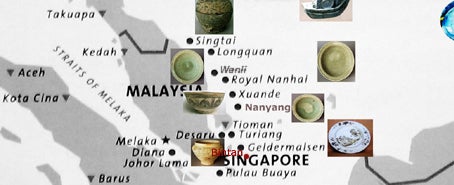
Turiang is the name given to a shipwreck found on May 13, 1998 in the South China Sea, not far from Singapore. Asian ships were probably unnamed, but it’s the habit of the marine archaeologist who found them to name finds after their cargos–this one was carrying a large amount of Thai ceramics, so Sten Sjostrand named it after one of the ancient names given the kiln site where many of the items originated from.
The shipwreck was discovered in 42 meters of water, 100 nautical miles from shore. Only the surface of the site has been investigated, but timber samples and construction details indicate that the ship was built in China. The ship is likely to have been 26 m long with a beam of 7.5 m, built in the Chinese tradition, with axial rudder, and with frames and hull planks joined by iron nails.
The ceramic cargo was found reasonably well stored, in compartments separated by transverse bulkheads. The Turiang‘s ceramics comprise Chinese celadon from the famous Longquan kilns, Sisatchanalai early green-glazed jars and bottles (this early green glazed ware is sometimes called pre-celadon), Sukhothai underglaze fish and flower plates, plus assorted pots from kilns in southern China.
The Turiang sailed with a multinational cargo of Thai, Vietnamese and Chinese ceramics, apparently heading for Borneo and/or Sulawesi (Indonesia), a major market for Thai ceramics. The wreck is dated to 1305-1370. This is one of the earliest shipwrecks yet discovered with Thai export ceramics.
The find prompted a reassessment of the relative importance of the two major production centers at Sukhothai and Si-Satchanalai. The Sisatchanalai site, in northern Thailand, was the earliest producer of high-fired ceramics and a consistent manufacturer for the kingdom from the late 14th century through the mid 16th century. The green-glazed celadon pottery, some with black under-drawings, is typical of the Chinese immigrant artisans.
About 95% of the 6500 ceramic pieces from the Turiang wreck were highly deteriorated after their long submersion in salt water, making the 350 or so intact examples quite rare.
In the Collection
Underglaze decorated fish plates from the Turiang (AD. 1370) shipwreck. The plates were made at the Sukhothai kilns by immigrant potters from Cizhou in northern China. The underglaze decoration, a stylized fish (long life) motif on top of a slip layer in iron oxide before glazing, is typical of the 14th -15th century production at Sukhothai. The one on the left (below) is one of the very few fish plates were the fish is pointing to the right. The base of the plate shows the typical Sukhothai clay with white (quartz) impurities, and they are exceptionally rare.

Pair of pre-celadon underglaze-ware plates, decorated with fish
Recovered from the Turiang shipwreck (ca. 1305-1370) by Sten Sjostrand
24 cm (9.5 in.) in diameter
The Coppola Collection
Historical notes: Large quantities of Chinese celadon in the Turiang cargo, and none yet found from Sisatchanalai, suggest that the Sisatchanalai kilns were not yet producing celadon, which would later become its most successful export. Until this discovery, it was thought that Sukhothai started underglaze production after Sisatchanalai had developed and exported celadon. The Turiang has forced a rethink.
Tubular supports were used while firing the Chinese celadon: both scars and remnants of the supports can be seen on these items. Tubular supports were adopted at both Sukhothai and Sisatchanalai; this evidence, that they were already in use at Longquan, suggests that they may have been introduced to Thailand by Chinese potters.
Fish designs show lively variation, but the range of fish motifs from Sukhothai is very similar to the range from Sisatchanalai. The fish shown below are all from Sukhothai.


